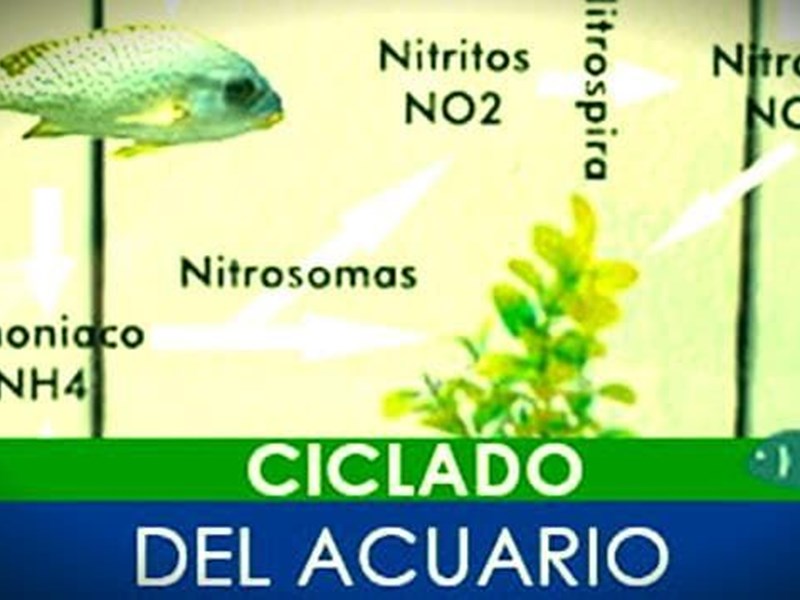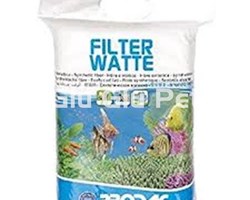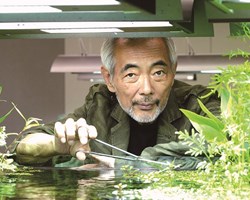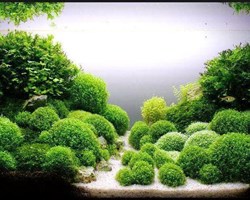
MY FIRST AQUARIUM:
In the aquarium, the fish are directly exposed to the action of toxins in the water.
These toxins are the result of decomposing matter and fish feces which results in AMMONIA or NH2.
The cycling is in order to create the so-called beneficial bacterial colony.
Which will reduce the toxicity of AMMONIA to nitrites (25 times less toxic) and then to nitrates (500 times less toxic).
To create this beneficial bacterial colony in your aquarium you need:
1- One month because they must reproduce in many millions to cover all the water and porous materials where they will also host. You can see this process in the following topic: NITROGEN CYCLE.
2- Oxygen: they are also aerobic bacteria (oxygen consumers) for which the water must have a movement in its entirety so that it is oxygenated in contact with the outside.
3- Food that simulates the waste of the fish (once a day or every day simulating the waste of a few fish because initially you will not be able to put many) thus it feeds the bacteria.
If we do not cycle or do not have a beneficial bacterial system in the water, if we introduce fish, they will be damaged by the ammonium resulting from the decomposition of waste, internal damage to organs.
Certain species die directly, others more resistant endure it but only internal damage to organs and brain lid which can bring life, leaving permanent damage to internal organs and brain.
HOW TO ASSEMBLE THE AQUARIUM:
It is recommended to set up your aquarium as if it were going to introduce the inhabitants, let it work as if it had inhabitants but WITHOUT putting the inhabitants in, without turning off the filter and the heater, and not changing the water.
It should be left for a month giving the necessary time for the beneficial bacteria to colonize the filter materials and when we introduce the inhabitants they are without any risk.
Initially there will be a high peak of ammonia that will go down as the population of bacteria that make it nitrites grows and at the same time nitrites will rise, which will cloud the water for 15 days until all the necessary bacteria are created to degrade the ammonia, reaching at this point the maximum peak of nitrites which will give rise to bacteria that will reduce these nitrites to nitrates.
This will take another 15 days during which these bacteria will reproduce, noticing that they will crystallize the water.
Once cycled, few fish should be added and continue taking care that the bacterial growth is gradual and/or without much toxicity to the fish.
At the end of cycling the aquarium, a beneficial bacterial colony is formed that will reduce ammonia to nitrates (500 times less toxic) but this colony is weak, it could not assimilate much waste.
For this reason, fish should be added gradually (after siphoning and a 20% water change).
Only few input so the bacterial colony adapts to the increased debris gradually.
This increase should not be excessive so it is not very toxic (this is the reason why fish is added little by little).
At the same time, toxicity should be reduced with siphoning and water changes while the colony grows and adapts b.
For two weeks intense siphoning and changes of 20% every 3 days.
WATER DECLORATION:
To dechlorinate, buy antichlorine and use the recommended dose, you must wait at least 10 minutes for it to take effect and not cause damage to the fish.
There are two options: chemically (anti-chlorine and conditioners for CHLORINE [gas] or CHLORAMINE [liquid]) or by evaporation (24 hours) only if the water contains CHLORINE because CHLORAMINE does not evaporate.
What does the water contain if CHLORINE or CHLORAMINE? There is a simple way to know, the safest and most useful thing is to do a chlorine test and thus you can know if it is dechlorinated by evaporation or not (chlorine or chloramine).
To chemically dechlorinate, conditioners or the so-called antichlor are used, which is SODIUM THIOSULFATE or HYPOSULFITE diluted in distilled water for liquid use.
This salt is also used at a rate of 1 gram per 100 liters.
PERCENTAGE AND WATER CHANGES:
The water changes of your first aquarium, should always be 30% of the weekly aquarium or maximum 10 days are necessary and along with it siphon only half of the aquarium.
If the first week you siphoned the left part, week 2 you will siphon the right part of each half, in this way you don't leave the substrate without bacteria and also without nutrients for the plants.
When making the change weekly or every ten days you will have to have the water near or at the temperature that the aquarium water is, this serves to avoid temperature shocks in the aquarium inhabitants and cause diseases in them and if you do not have another heater you can pour new water slowly (5 mm hose).
To the aquarium so that the temperature stabilizes little by little and the inhabitants do not suffer and cause sudden changes in temperature, weakening their immune system.
THE RIGHT CHOICE OF AQUARIUM:
This topic is extremely important when setting up your first aquarium, although it may not seem like it at first glance, it is one of the most important in the world of aquarium hobby.
When we have it for the first time, we believe that the more fish the better, but we are not taking into account the growth of the fish or rather we do not realize the size of the fish that it will reach as an adult and the space it will need.
The characteristics of the fish that we plan to introduce to the aquarium, it is recommended to buy a larger aquarium than we had planned to buy.
It is very important to investigate the needs of the fish that we are going to introduce in the aquarium and when we have already investigated and chosen, buy the corresponding aquarium taking into account the measure that the fish will need as adults, because otherwise it will be small in the future and you will have to buy a bigger aquarium.
If not, the feces of the fish, being large, will be many and will affect the water and will end up killing the fish or fish due to lack of space and the toxicity caused by their waste.
Need for water changes:
Water changes initially or depending on population and aquarium conditions weekly by 30% (no more) would be correct and in aquariums with settled bb colony (months) every 10 days at most.
They must be siphoned from the bottom, this is to extract the remaining waste that the ecosystem did not assimilate and waste.
If you don't siphon this waste it will produce several things:
-Excess nutrients (in the chemistry of the water) that would penetrate the gravel and with that eventually raise phosphates (produces cyanobacteria and algae).
- Too many nutrients that would produce an aerobic and anaerobic overpopulation of bacteria, this could excessively raise nitrates over time and/or produce putrefaction of the substrate that would affect the water, cause algae, etc...
HIGH NITRATES IN AQUARIUM
That is why siphons are very necessary.
Then it comes and everything together.
The bb colony Reduces waste to nitrates, which is the less toxic substance to which ammonia is reduced from feces and plant waste.
The remaining remains are siphoned.
And with the water change, nitrates are reduced by dilution.
Amount of water to change and care:
Water changes should not be too large, otherwise they would greatly reduce the bb colony and this would produce an excessive lack of bacteria and would affect the water, greatly increasing toxicity.
Therefore, you should not make changes that exceed 30%.
If it is done 40 or 50 in cases of need (due to water quality problems or poor cycling) but it is done in two or 3 weekly changes.
Ex: 3 changes with siphoning of 15% weekly or 2 of 20% with siphoning.
The water contains beneficial bacteria in the water and porous materials
cycled
Beneficial bacteria are in the water
You change the water from 25 to 30 weekly with siphoning always.
NEVER ADD TOO MUCH COLD WATER AT A SNAP!
You must take into account the temperature of the new water, if it is colder than that of the aquarium and pouring it quickly would cause a thermal shock that would affect the immune system of the fish, leaving them prone to any disease and to be parasitized by ich or white spot, as well as others. parasites that live with our fish.
Therefore, when changing water, if the new water is colder than that of the aquarium (test with your finger), you must discharge it slowly, for this use a 5 mm hose and a siphon to discharge the water.
This will cause the download to be delayed and will not affect the ecosystem.
Water changes should be weekly or every 10 days at most, this also depends on several factors.
Factors that regulate percentage of water to change:
- A high liter aquarium is much more stable and better assimilates waste.
- Quantity of food, overfeeding produces the excess that rushes us to change the water.
- Of course a well cycled bb colony is needed and also the presence of plants helps a lot if there is one, because they consume the ammonia, nitrites and nitrates that are made from the waste.
An aquarium that has a high liter in relation to fish and many plants can change 50% of its water because it does not need as much bacteria due to the action of the plants and since there is little waste, the plants consume the resulting ammonia, leaving what is left for the bacteria that already pass into the background.
He clarified that this varies a lot according to the density of plants and population and others such as intensive siphoning. , have gravel that accumulates waste, plate filters, etc...
Here is a link about it:
plant need
I hope I have not extended it too much, but I think these topics were linked and would make you understand more how to do water changes, how often and reasons, greetings, ask any questions.
Purpose, what do beneficial bacteria do?:
The purpose of cycling and forming this colony of bacteria is to reduce the toxicity of the ammonia that is made from feces and decomposing matter.
In other words, they are essential for the degradation of waste!
The beneficial bacteria reduce the toxicity of ammonia to another substance called nitrites. (25 times less toxic) and then to nitrates. (500 times less toxic).
Therein lies the great importance of the beneficial bacterial colony! Well, ammonia is very bad for fish or kills them.
Beneficial bacterial colony, what are they?
These bacteria are AEROBIAS (oxygen consumers), called beneficial water or aquarium bacteria, also called BENEFICIAL BACTERIAL COLONY:
That we have ammonia or ammonium is due to the pH and temperature of the water, the higher the pH and temperature, the more ammonia we will have and on the contrary more ammonium, with a pH below 7 and a temperature of 25º I consider optimal for most common or beginner species too.
These aerobic bacteria consume oxygen and convert ammonium (NO3) resulting from fish feces and decomposition of organic matter, some oxidize ammonium making it nitrite (NO2) called Nitrosomonas.
And others that oxidize nitrite turning it into nitrate, called Nitrospirae and nitrobacter.
What is Nitrate? Aerobic and Anaerobic bacteria.
Nitrate, which is the most oxidized form in which we can find nitrogen and less harmful or toxic in an aquarium or pond.
As you know, the aerobic or beneficial ones produce it and there are the opposite ones, those that live and reproduce in environments without Oxygen and these consume Nitrates.
This Nitrate can be extracted in water changes or consumed by plants (natural filtration), or by anaerobic bacteria (non-consumers of Oxygen)
Therefore, anaerobic bacteria are the cause of rot and deterioration in the aquarium.
In a biome there is a constant war between them, with poor oxygenation the Anaerobes win and will cause putrefaction and produce very harmful Methane gas and Sulphides as a result of their feeding,
Conversely, in a well-oxygenated biome, life and beneficial bacteria that reduce toxins will overflow, for this, oxygenation and circulation of water at the bottom and on the surface is very important.
To live these beneficial bacteria need:
- Source of ammonium (fish waste and organic matter)
- Oxygen dissolved in the water (such as fish)
- Stable water conditions (like fish) and stable temperature as well as fish temperature shocks affect them
- A place to live. They are fixed-living bacteria that can inhabit the substrate, aquarium water and aquarium filter elements.
For this reason, it is necessary to take care of its habitat and never reduce it too much, neither in its water nor in the cleaning of the filter and gravel. and for what has already been mentioned.
bacteria in filters
For this reason, the function of the filters is not to filter the water only, but its purpose is to house a sufficient bb colony to consume the aquarium waste, a filter without the bb colony would be a source of rotting decomposing matter, This usually happens if it is poorly organized (it even gets covered) or if you wash it with chlorinated water, not preserving the bb colony.
What is the difference between filtered tap water and cycled water?:
Purified water can be totally filtered of all chemical or organic matter as well as bacteria, that is, totally clean of everything.
But that clean water of bacteria and everything ONLY serves us to renew their water, the water they need to be better is the water of their own aquarium, which is also a host to millions of aerobic or beneficial bacteria of the bb colony.
Reduction of bacteria by removing a lot of water
For this reason, it is only advisable to change up to 30%; this colony, I remind you, absorbs ammonia from feces,.,
So if you changed MORE than 30% of the water, you would be reducing the colony in excess; this would cause an increase already the next day matter that generates ammonia (from feces and plant waste); since the colony was reduced and they have less absorption capacity...
And if you changed more % water to more NEW WATER faster the water would become more toxic for them,...
It should be added that it is a %, since the bacteria are found in the substrate and the filter; It's not normally deadly.
But if the fish are intoxicated, this weakens them leaving them prone to entry to all kinds of diseases or parasites that are deadly.
What happens when removing more water (ex: more than 40%), is that it is reduced as the bb colony told them, this will initially cause an increase in ammonia due to the missing bacteria, this ammonia will give birth (or encourage reproduction aeronomous bacteria that consume ammonia) bacteria that oxidize it to nitrites.
Then the ammonia will begin to drop as the nitrites rise (while the population of nitrosomonas bacteria grows that will supply the missing ones), these nitrites are very toxic and will continue to rise until the nitrosomonas bacteria are all there, and this takes days, in the cycled takes 15 days.
In an aquarium that has reduced its water, it will take fewer days to reach the maximum nitrite peak (it is visually characterized by clouding the water) but it will be very dangerous and toxic for fish.
Once this maximum peak of nitrites is reached, these same nitrites will give birth to the bacteria that will oxidize them to nitrates, their toxicity is necessary to give birth to these bacteria that will complete the nitrogen cycle. Then the nitrites will begin to decrease and the nitrates will rise as the bb population is completed.
How to treat in cases of bacterial reduction that nitrites affect the fish as little as possible there are certain tips.
- More regular water changes to reduce nitrites by dilution (10% every two days)
- Siphon intensively at each change trying not to leave waste so there will be less matter that will raise nitrites quickly.
- Reduce the food to a minimum so that there are no remains
This would soften this process, also the plants would be very necessary in those cases both the bottom ones (try to put as much as possible) and the floating ones since they consume the ammonia (and nitrates) from the water reducing nitrites as there is less than ammonia to oxidize.
I also recommend using the terrestrial plant called poto or pothos, it is placed on the aquarium with the roots in the water, they are high consumers of ammonia.




